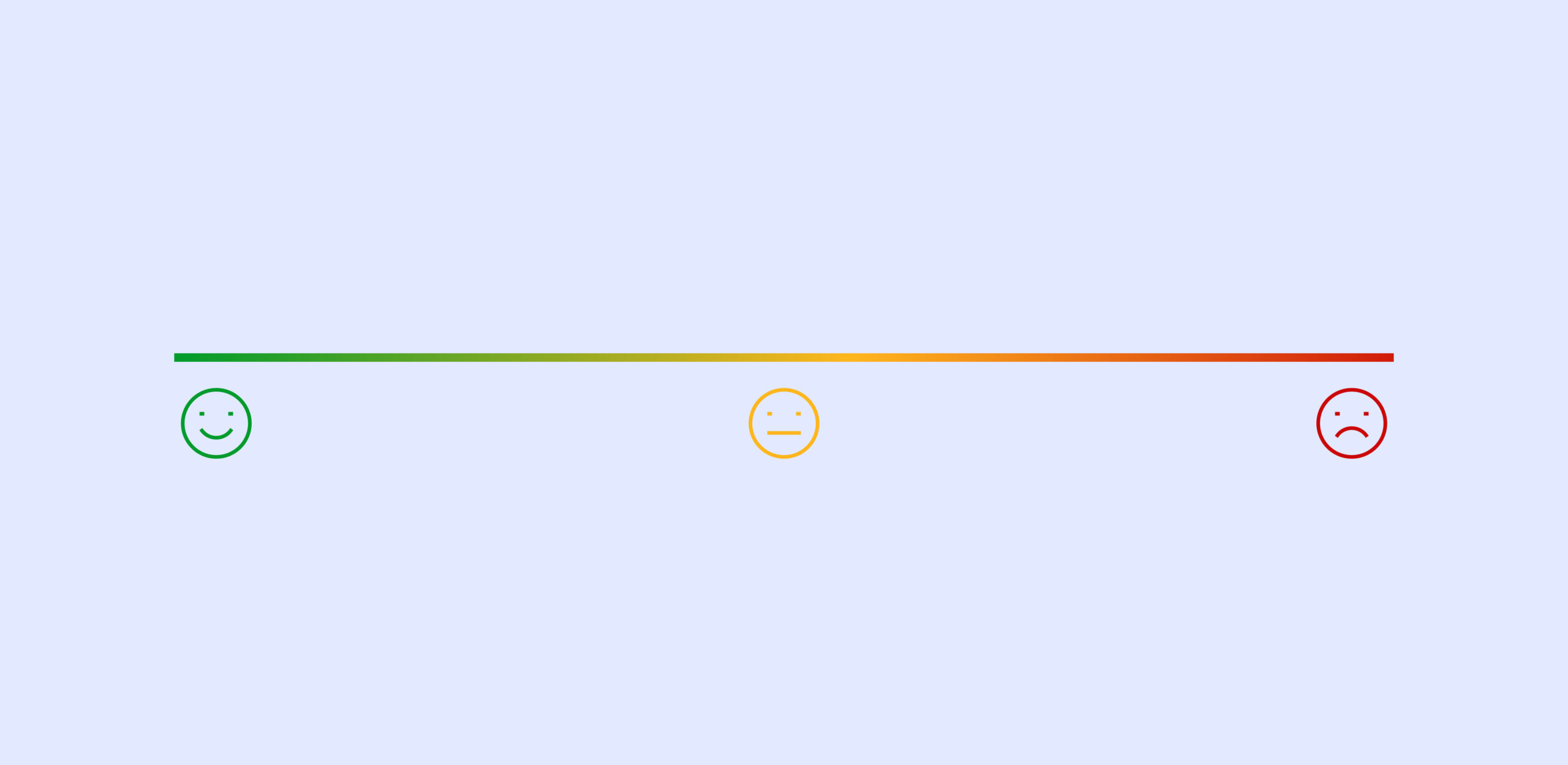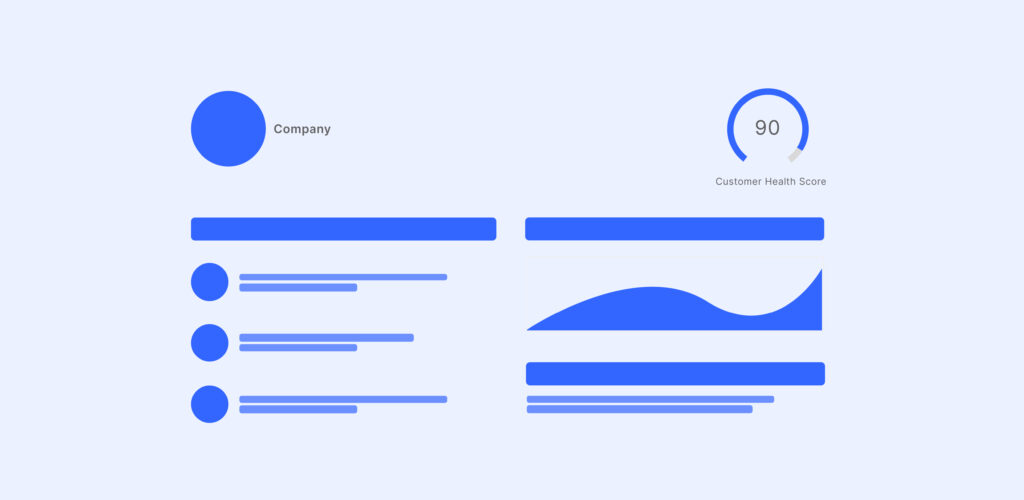What metrics do you track in your business in order to see whether you are taking the correct steps?
- Monthly Recurring Revenue (MRR)?
- Customer Acquisition Cost (CAC)?
- Or Net Dollar Revenue (NDR)?
It is already 2023, and I’m sure you know that only these won’t work. You can’t be stuck on the coming and going dollars for your business to scale faster and become more profitable.
You have to dig deeper.
But don’t worry, you won’t have to measure every single metric that has been invented on this earth either.
Binding metrics bring a variety of essential metrics together, such as the CHS (Customer Health Score).
Today, I will dig into what Customer Health Score is, show you how to measure it, and discuss how to create a CHS dashboard.
Let’s get into it:
TL;DR
- Customer satisfaction is vital to keep your business up and running since the customer’s happiness directly impacts how effective the revenue you generate will be.
- The Customer Health Score is a crucial indicator of how satisfied your users are and gives you actionable data about what you should do.
- There is no “magical formula” to calculate the customer health score. It depends on your most crucial churn/upgrade-related metrics.
- To calculate it accurately, you should first find key metrics that indicate churn risk and upgrade opportunities.
- Then, you need to determine segments with different patterns/journeys.
- Last but not least, you should determine the impact of each of those segments and allocate a certain weight to each of them.
Importance of Customer Satisfaction in B2B SaaS
Customer satisfaction is key to seeing the dollars in your vault to stay in your vault.
Because acquiring a new customer can be 7x more expensive than retaining an existing customer, you have to do your best to keep the current customers satisfied rather than letting them go and acquiring new customers.
Let’s visualize this with an example:
Let’s say you have 10 existing customers, bringing $ 10$ in monthly revenue. The cost to retain all those is 1$ each. This brings your net dollar revenue to 90$ per month.
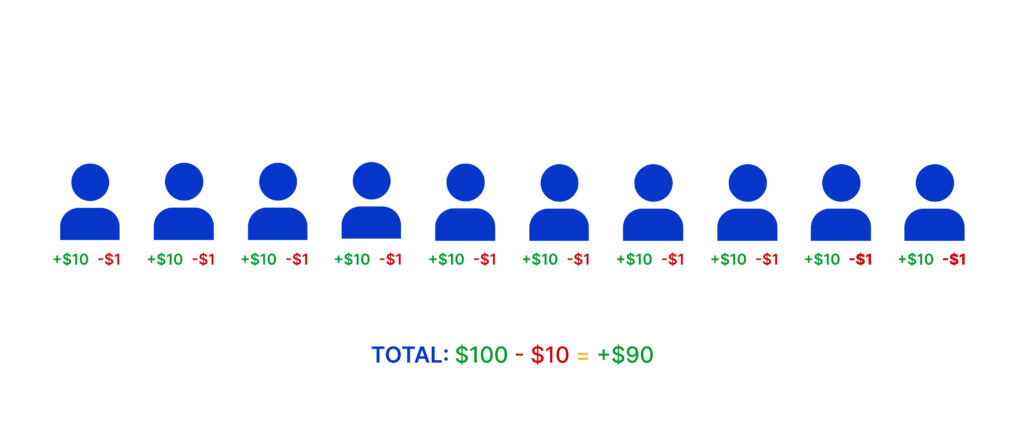
Last month, let’s say that you lost 2 of those customers but successfully acquired 3 new customers. So you have 8 customers that bring 10$ and cost 1$, and you have 3 new ones that get 10$ but each cost you 7$.
Now, you have 1 more customer, so you should have a higher revenue, right?
Well, the money in the bank says something different.
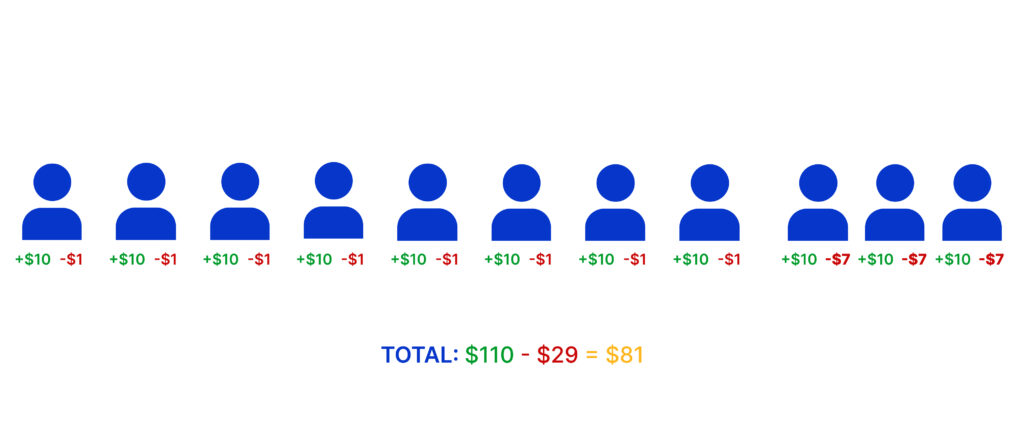
This is why customer satisfaction is essential. You want to keep the paying customers in. You want to retain them because customer retention cost is cheap(er).
And how do you really know whether your customers are satisfied?
That is precisely where the Customer Health Score comes in.
What is Customer Health Score?
The Customer Health Score is a metric that provides SaaS businesses with a measurement of customer engagement and satisfaction.
It gathers meaningful customer and product usage data and predicts their behavior in a given period. To accurately determine the customer health score, you should evaluate different data points, and segments according to their needs.
The Customer Health score isn’t a singular metric, it’s an accumulation of data collected in one place and analyzed through one aspect: “Is this customer happy with us?”
Unlike NPS or CSAT scores, it doesn’t depend on a single survey. Instead, the Customer Health Score comes from a variety of data you chose to provide, generating an overall and accurate score about how the customers are doing.
This way, it gives your customer success team time to breathe while the CHS easily highlights the accounts likely to buy, at the risk of churn, and those ready to upgrade.
Customer Health Scores in SaaS
Customer Success is one of the most essential parts of a SaaS business, and the Customer Health Score is an important way to measure this.
The reason?
Customer Success depends a lot on how users interact with your product, including how often and which features they use.
If they don’t use certain features, or they are not actively using product at all, it could mean that they aren’t getting the most out of your platform, which could make them more likely to churn. It’s important to remember that signs of churning often show up a long time before the actual event.
By finding and fixing problems, you can help your customers get higher scores. This not only helps retain customers, but it can also help you get more customers through word of mouth. Referrals are a powerful way to market in SaaS, especially for services that cost more or take a long time to complete.
How to Calculate Customer Health Score?
There is no “one true way” to calculate the Customer Health Score. The calculation differs from company to company and can even vary for different needs and requirements.
However, there are specific methods to determine how you should calculate your health score and how you should analyze it.
For starters, you should find your defining metrics that are most related to the happiness of your users. How do you know if a user is about to churn? Which data tells you about the accounts that are ready to scale up? Find all those metrics and put them in a pot.
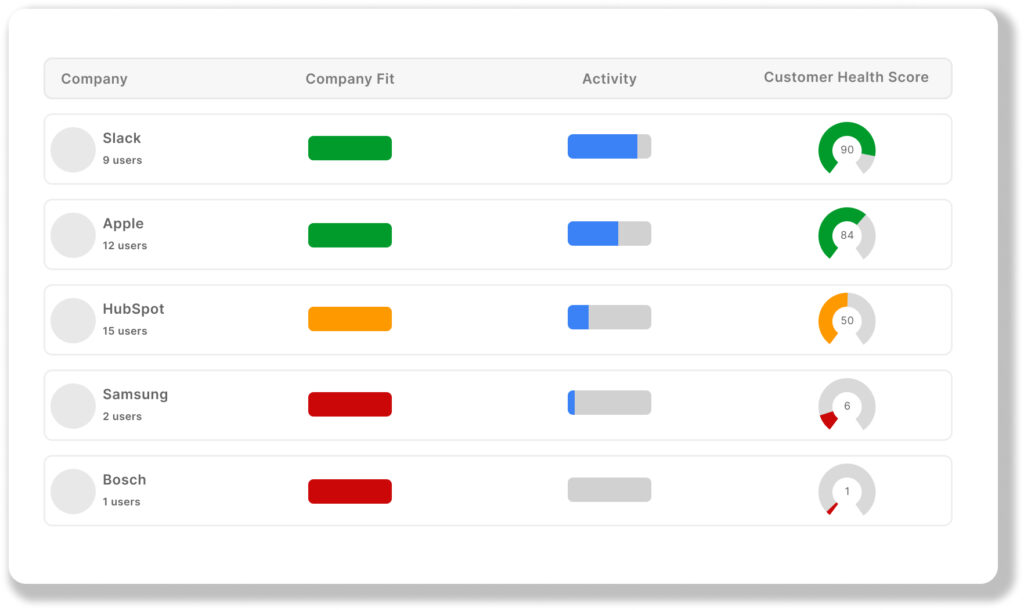
With the help of the correct tool, you can see the customer health score as a rating and/or color-coded for ease of access.
As I said, calculating the Customer Health Score doesn’t depend on a single formula. It’s a process that differs with different data points included and different weights.
And, of course, I won’t let you off this article without showing you how to calculate it.
Here are the steps to implement CHS for SaaS:
Steps to Implement Customer Health Score for SaaS
Step 1. Determine the Right Metrics
At this point, you should know which metrics accurately tell how customers like their time with your product.
Usually, those metrics are some of those below:
- Product usage
- Customer fit
- Account activity
- Feature usage per month
- Growth of account
- Renewals vs. payment issues
- Last seen period
- Support tickets
- Product feedback metrics (such as NPS)
Depending on your approach to acquisition and retention, find the most important ones and get help from a tool to track and combine all of those. This could be an analytics tool, but the best tool to give you the most accurate CHS prediction is a Customer 360 tool.
Step 2. Weighting and Global Health Score
As I mentioned, the Customer Health Score doesn’t have to provide an overview of the whole tool. You can set different health scores for different metrics, segments, or cases.
The importance of each of those will be different. So, if you are willing to calculate a Global Health Score by combining all this data, you have to be able to weigh all data differently.
For instance, the health score for segment A could weigh 30%, while the more critical B metric could weigh 70%, giving you an accurate global health score.
Once you determine all the priorities and weights, you can go on to create an action plan on “what to do with the customer health score?”
Step 3. Leverage Your Health Scores
Now that you have your scores and your data in one place, you need to figure out how to take action.
You can:
- Analyze the data manually, spend a lot of time, deploy one customer success representative solely for this purpose, and reach out to high-low-scored users manually.
- Automate the process with the help of your CHS tool and send emails or Slack messages automatically when a desired score is reached, or a specific action is complete.
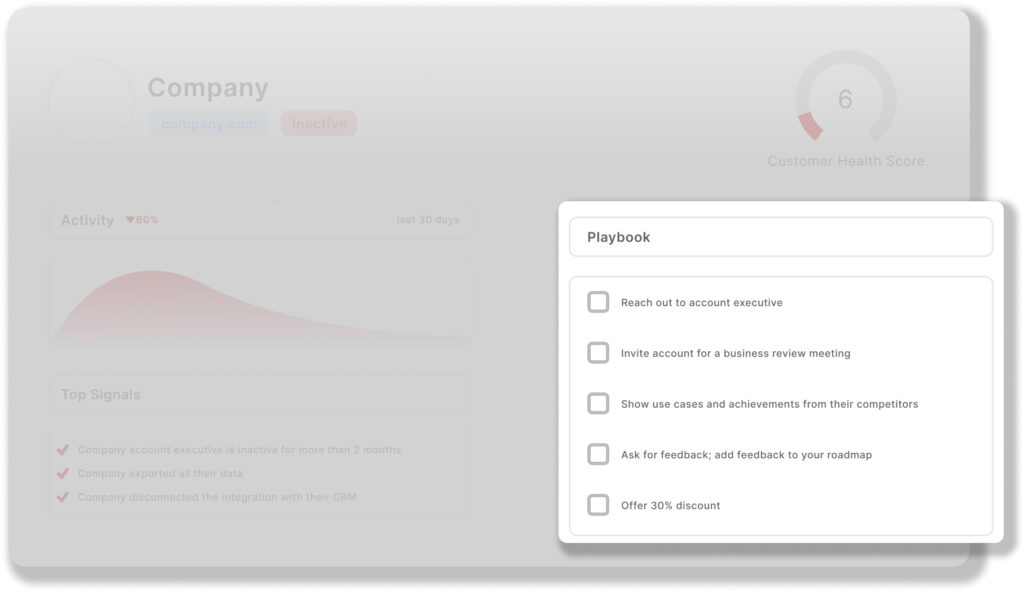
With expert-made playbooks, you can easily take necessary actions and automate your process.
Customer Health Score Dashboard
“Hey, how do I monitor all this data and all these different health scores?”, you might ask.
This is where Customer Health Score dashboards come in handy.
I already mentioned about Customer 360 view, which is a complete view of the customer with all data points, details, and a customer health score.
The customer health score dashboard, similarly, is a complete view of all your customers with a customer health score, ranked and filtered as you wish. It gathers the relevant data, presents it in a single dashboard, and develops an action plan. You can also create custom dashboards for you to have a full view of all scores on a single page.
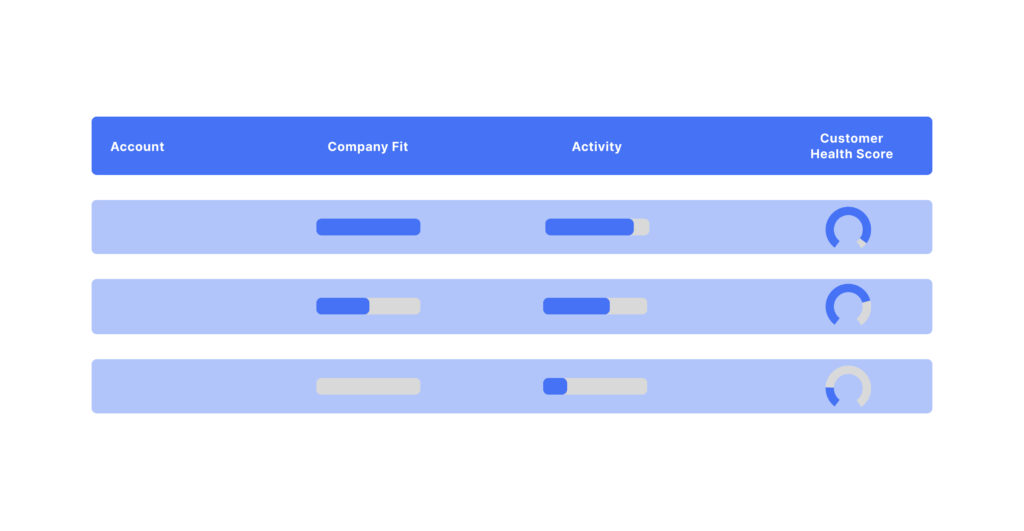
Here is why these dashboards will be your custom success team’s best friend:
Components of an Effective Customer Health Score Dashboard
An effective CHS dashboard helps you monitor:
Score Trends Over Time
By comparing data in quarters or years, you can figure out how seasonality affects your company, and focus on necessary actions that work best for each season/quarter. This can help you allocate your necessary time correctly and get the most out of each project – without repeating similar mistakes each time.
Drill-down Capability
Customer health score services allow you to choose which data to track and create your own dashboards. This way, you don’t only see the data but also have the option to drill down and know why some changes have occurred and what patterns cause change, and it gives you a better idea of what you should do to maximize retention.
Alerts and Notifications
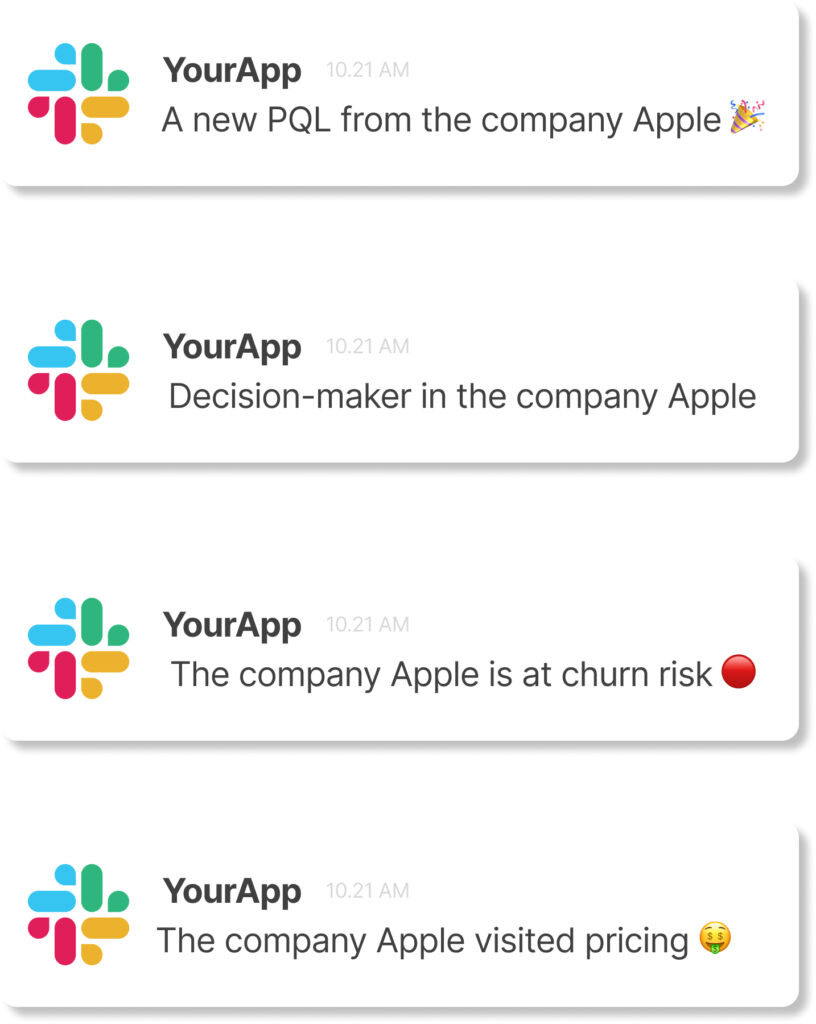
Unlike free analytics tools such as Google Analytics, Customer 360 tools with a well-developed customer health score dashboard provide you with Slack notifications and email alerts for changes and reached benchmarks so that you don’t have to worry about missing out on anything. In short, these tool provides a healthy space to collect data and calculate health scores and automatically informs you about when you can/should take action.
Integrations with SaaS Tech Stack
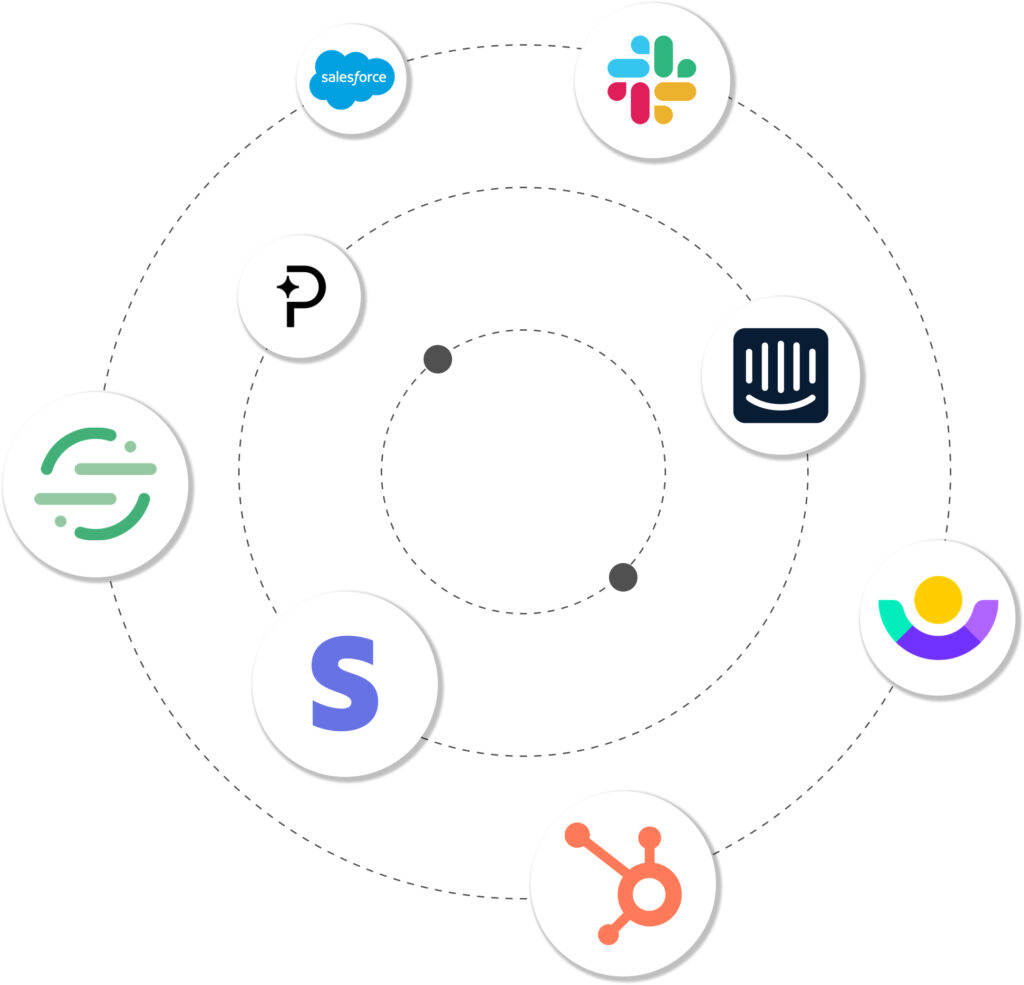
The most important aspect of a CS tool is that you can integrate all your 3rd party tools with it and gather all related data on one platform. This will save you from comparing all kinds of data separately or trying to combine them on a spreadsheet. By easily collecting and visualizing your data on the dashboards you set, the steps you take will have more impact, as there will be no space.
Customer Health Score Checklist for SaaS Businesses
Let’s go over all the steps we have talked about so far in order to have the perfect strategy to get the most out of your metrics and Customer Health Score:
1. Define Your Metrics: Ensure they align with your business goals
Metrics that should be counted to calculate Customer Health Scores differ greatly across various industries. You should find the most important metrics to your company that determine churn risk and dive into patterns that indicate an upgrade possibility.
Some common metrics include:
- Product Usage: Both how much of the product is being used and how much can be used (the number of licenses).
- Core Feature Engagement: Find out how often customers use your product’s most important features.
- Account Growth: Keep track of whether or not customers are upgrading their service tiers over time.
- Relationship Length: Keep track of how long you’ve known each customer.
- Renewal Rate and Payment History: Look at how often a customer has renewed their contract and keep track of any payment problems that keep coming up.
- Support Tickets: Keep an eye on how often and what kind of support tickets you get.
- Feedback Metrics: Look at the feedback you got to see where you could make changes, like feedback from NPS surveys.
- Marketing Engagement: Find out if your customers are recommending your product to other businesses or if they are willing to work with you on case studies.
If users with high NPS scores and low ticket counts stay with you the most, put those two in the basket and define a health score based on them.
If your users tend to send more tickets, but the most active ones from a certain industry regularly upgrade to a higher plan, then ditch the ticket count and create a new health score.
You can rinse and repeat this process easily within customer health scoring tools until you are satisfied with the results, and see real actionable insights.
2. Assign Weights to Each Metric: Understand their individual significance
Not all metrics have the same importance. Therefore, SaaS businesses should understand the individual significance of each metrics and assign different weights in the calculation of the Customer Health Score.
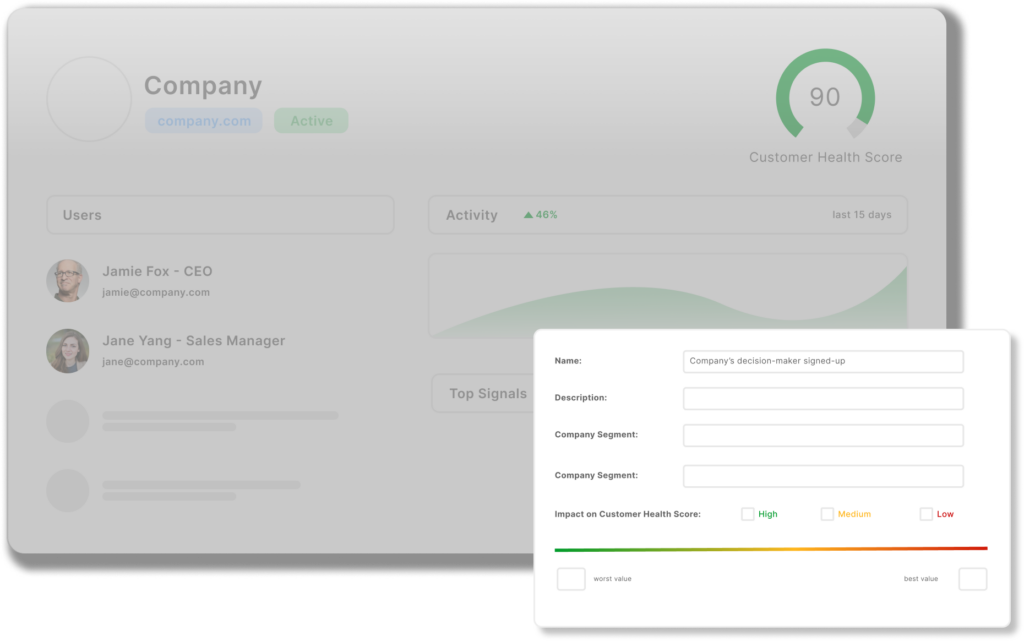
For example, while login metrics or numbers might have a no, or “Low” effect on the Customer Health Score, metrics related to completing key actions, like setting up integrations or importing data could be given a “High” or “Medium” weight, especially if they are important to the user experience of your product.
Additionly, for instance, if you have 3 segments that you are tracking, then see which ones bring in the most revenue, which ones churn less, and which ones require less support.
The segments with fewer people in them, or the health score of a certain rare group shouldn’t weigh the same percentage as your most important customers.
3. Integrate with Other Systems: CRM, support desk, etc.
Don’t calculate your health score when you collect your support tickets in another tool and have 3 different analytics tools set up.
Gather all the data within your Customer 360 tool, and have a holistic view of all actions, changes, upgrades, and recurring requests.
This will save you lots of time, making it easier to find patterns and work on them. Beneficial integrations for a holistic view;
- Integration with CRM: It allows data to flow in both directions, making user and company data management easier, and tags users based on their likely actions, such as whether they will buy something or leave.
- Support Desk Integration: Connect customer and company data, predictively prioritize customer inquiries and issues, and use forward-thinking insights and actionable advice to engage customers.
- Payment Platform Integration: Exchange financial data to monitor transactions, capturing each customer’s payment behaviors, subscription details, and challenges.
- Event Data Integration: Channel real-time event data to enhance customer scoring and adjust predictive models based on user interactions.
- Communication Platform Integration: Stay updated on every customer activity within communication tools and receive alerts about key engagements.
4. Monitor Regularly: Adjust based on trends and feedback
Having said recurring requests, don’t forget to keep an eye on regularly occurring events. Do certain groups churn at a certain point? Do you get fewer signups at a certain quarter?
Monitoring this data will help you allocate more time for the best project each month. Distributing your work on the most suitable timeline will prove to be a game-changer.
5. Communicate Scores Internally: Ensure all teams understand their impact
Your Customer 360 platform, where you track your health score should be able to connect all teams on the same platform. Some of those teams are:
- The customer success team,
- The sales team,
- The growth/marketing teams,
- The product team.
Connecting all teams that are directly in relation with your customers on the same platform will ensure that everyone is on the same page, and can act on changes immediately.
6. Act on Insights: Use data to refine strategies and actions
And lastly, don’t leave the data just be. Find action points, or even better, let your tool determine whether the action points you have set have been reached or not. Get notifications about upgrade opportunities, churn risk alerts, and unexpected changes.
Strategize using the data, and never fail to accomplish a goal just because you couldn’t see it at the time.
Conclusion
At the heart of SaaS businesses, with their subscription-based nature, is the reliance on recurring revenue. With this setup, it becomes clear that customer success is the most important thing. As a result, customer health score is an essential part of any SaaS business.
Customer health score is a collecive metric that customer success teams can rely on (when set up correctly as we tried to explain in the checklist) to measure the satisfaction of their customers to predict early churn risks, detect up-sell opportunities and let more customers to come in!
Frequently Asked Questions
How do you evaluate customer health?
You should evaluate Customer Health through a combination of product usage metrics, feedback, and engagement patterns. Combine all those data in a tool, like Usermotion, and you can have an accurate health score for each customer.
What is the formula for customer health score?
There is no set formula to calculate CHS. Typically, it is a weighted average of individual metrics defined by the company’s different teams (mostly customer success teams).
How do customer health scores differ from other metrics?
Unlike NPS or CSAT, customer health scores provide a comprehensive view, incorporating various metrics to gauge the overall customer relationship health.

